Introduction
Bioeconomy and Circular Economy themes are at the top of political agendas in many countries (Moosmann et al., 2020). Proof of this is the large number of policies and strategies formulated on the Bioeconomy that affect all areas of life and the economy and that require broad social support (Hafner et al., 2020). The application of these concepts aims to improve a number of sustainability challenges, such as raw material shortages and global warming (Temmes & Peck, 2020; European Commission, Directorate-General for Research and Innovation, 2018), population growth, food security, poverty and health (McCormick & Kautto, 2013; European Commission, Directorate-General for Research and Innovation, 2018). These concepts are perceived as fundamental tools for sustainable and inclusive economic growth and job creation (European Union, Joint Research Centre, 2018). The transition to the Bioeconomy is also seen as a means to achieve industrial competitiveness (Oriama & Pyka, 2021).
The concept of Bioeconomy is associated with sustainable development changes and involves transitions in both production and consumption within systems. Many of these transitions are related to the use of renewable resources, for example forest biomass, to meet basic needs such as food, energy and housing. However, all stakeholders must be aware of the Bioeconomy so that they can successfully contribute to this transition. Furthermore, of all the stakeholders, the future generation is particularly important, as they are also the managers of this area in the near future. Society’s awareness and perception of the Bioeconomy, Biologically Based Products and Processes and the sustainable use of resources can contribute to environmental sustainability, but intensified efforts are needed to increase their public acceptance (Wozniak, Tyczewska & Twardowski, 2021).
As argued by Dieken et al. (2021), the lack of collective ecological concerns, reflected in the scarce existing research on civil society actors, suggests a gap between the Bioeconomy as a concept of sustainability and the perceptions of the actors involved, being essential, a more active participation and strength of the Society, both in research and in policy-making. In this context, the Media can function as agents of change and contribute to the acceptance of the Bioeconomy through the dissemination of successful experiences of innovation and valorisation, adopting a transformative social vision that gives relevance to the interconnection between multiple actors, multifunctionality and rural development (Sanz-Hernández et al., 2020). According to Macht et al. (2022), the perception of a Bioeconomy transition depends on the specific technologies that will be implemented and the way these technologies are communicated to the general public. Successful information campaigns must not only highlight the benefits, but also discuss challenges and potential conflicts so that they can be trusted by citizens.
Therefore, it is proposed to carry out a bibliometric analysis by the method of binary counting, using the technique of co-occurrence of words, with the objective of grouping the existing literature into clusters, to know in a broader and deeper way the themes developed, in the literature, within the scope of perspectives on Bioeconomy and to identify the main lines of research on this topic.
This article is organized into five sections. In the first section, the theme is justified, the objective is described, a brief reference is made to the methodology used and the structure of the article is presented. The second section organizes the literature review on the perspectives about Bioeconomy. The third section describes the methodology used in this research. The fourth section describes and discusses the results. Finally, the fifth section presents the conclusions, suggests guidelines for future research and points out the limitations of this research.
Theoretical Framework
Bioeconomy can be considered an area dependent on Economics. A complex area of which three essential elements are part, namely, knowledge, renewable biomass and application integration (Stern et al., 2018a), which involves several sectors of activity, namely, Agriculture, Forestry, Fisheries, Food, Feed, Pulp and Paper Production, Chemical, Biotechnology and Energy Sectors, Service and Consumer Sectors (Wozniak, Tyczewska & Twardowski, 2021). The transition to a bio-based economy has been accompanied by an increasing demand for biomass resources, in an attempt to meet the need to replace fossil fuels with a more sustainable production of consumer goods, chemicals and energy (Wensing, Carraresi & Bröring, 2019), simultaneously providing food security and biomass as a renewable raw material for industry (Lokko et al., 2018).
Bioeconomy has been presented as a potential answer to some of the issues facing modern humanity, namely, climate change, industrial restructuring, food security, health and energy security (Grubor, Milicevic & Djokic, 2018). According to Urmetzer et al. (2022), Bioeconomy provides a framework for potentially effective solutions in economic development that address major global challenges through the increased use of biological resources, renewability and circularity. A path to take to achieve a more equitable, environmentally correct and future-proof economy, but which depends heavily on the regulatory barriers imposed by Science, Society and Business (Urmetzer et al., 2022). In the opinion of Dieken and Venghaus (2020), its implementation depends not only on new products and production processes, but also on the balance of different interests, values and interpretations of the concept. The lack of inclusion of the perceptions of social actors can result in a lack of acceptance and commitment to the Bioeconomy at the consumer or citizen level (Ramcilovic-Suominen & Pülzl, 2016). The scarcity of scientific studies that include social issues in relation to the Bioeconomy makes the transition from the current model of organization of Societies to the Bioeconomy a failure (Masiero et al., 2020). In this sense, among all the actors, the future generation is particularly important. To make predictions about the future development of Bioeconomy, it is necessary to understand the perception of the future generation of stakeholders, namely, higher education students in areas related to Bioeconomy.
Dallendorfer et al. (2022) developed a study in Germany directed to civil society. This study aimed to understand the general public’s understanding of the term Bioeconomy, citizens’ level of knowledge, fears and expectations, as well as identifying factors that explain their attitudes towards Bioeconomy. The results indicated that citizens are not very familiar with the concept, however, the ideas underlying the Bioeconomy are widely appreciated. According to the authors, support for a sustainable Bioeconomy is strongly related to expectations not only of economic benefits, but especially of environmental benefits. Furthermore, the support to Bioeconomy is linked to beliefs that reflect environmental concerns and pro-environmental behaviour.
Taking into account the research carried out among future strategic groups, reference can be made to the study carried out in Slovakia by Výbošt’ok et al. (2022) which aimed to analyse the perceptions of Bioeconomy involving 398 students (bachelor and master) from the Technical University of Zvolen, from three courses related to Bioeconomy (forest sciences, wood sciences and natural resource management). The results showed that more than two thirds of the respondents had already heard about Bioeconomy. The three main sources of information were the news, university courses and the Media. Only forest science students indicated greater diversity in the identified sources of information. The perceived contribution of the Bioeconomy of the different sectors is substantially the same regardless of the course they attended. Furthermore, at the European level, the bioenergy, biofuels and forestry sectors were “often” indicated as contributing to the Bioeconomy, while the agricultural sector was indicated “less frequently”. Regarding the perceived importance of forestry for the Bioeconomy, students reported that it was of “greater importance”. In general, students perceive that the development of Bioeconomy based on the forest sector allows and favours the sustainable management of the forest. These results were similar to those found in an exploratory study carried out by Masiero et al. (2020) which included 1400 students (bachelor and master) enrolled in 29 universities in nine European countries, namely, North (Finland and Sweden), Midwest (Austria, Germany and France), South (Italy and Spain) and Eastern Europe (Slovakia and Russian Federation) that offer courses in forest science. According to the results, about 70% of the respondents have already heard about Bioeconomy, mainly through university courses. Students perceive forestry as the most important sector for the Bioeconomy. However, the extent of forestry’s perceived importance varied between countries, with significant differences between country groups along the North-South European axis.
Another study, carried out in Finland, analysed students’ perceptions of their familiarity with the use of wood in the construction of multi-storey buildings and related these perceptions to consumption styles (Kylkilahti et al., 2020). Apparently, expenses and ecological awareness are associated with a positive perception on the part of consumers. On the other hand, the increase in knowledge and awareness, for example about the use of wood in construction, together with the increase in environmentally conscious consumers, focus public attention on central issues of the sustainable Bioeconomy. Stern et al. (2018a) carried out a survey that was based on 456 interviews with students, employees, farmers and pensioners residing in Austria and whose objective was to analyse the perceptions of the Bioeconomy by individuals from different social groups. This study revealed that of the different social groups analysed, farmers seemed to be the most sceptical, critical and negative in relation to the Bioeconomy, while individuals with a strong attitude towards ethical consumption had a more positive perspective. Also, sustainable consumption was mentioned as an important topic of Bioeconomy by all participants. In the opinion of Rossi and Hinrichs (2011), scepticism about the social impacts of the agricultural bioeconomy results most often from observations of corporate control in agriculture in general.
In summary, Bioeconomy is considered a strategic concept of sustainable development with high potential that allows the implementation of current economic objectives through the adoption of new technological solutions, with reduced use of natural resources and reduced environmental impact (Krajewski, 2019). As one of the primary goals, sustainable green growth, the Bioeconomy depends heavily on the agricultural, food and forestry sectors (Grubor, Milicevic & Djokic, 2018).
Research Methodology
This is a quantitative study that involved the development of a bibliometric analysis based on a bibliographic search carried out in June 2022, which focused on the publications available in the Scopus database. In the search, only publications that contained, in the title, abstract or keywords, the “Bioeconomy” and “Perceptions” words were considered (105 results). Subsequently, a filter was used, limiting the search to three major scientific areas, namely, Environmental Sciences; Social Sciences and Agriculture; and Biological Sciences, with 81 publications being counted. Finally, only documents of the “Article” and “Review” type were considered, subject to blind peer review, totalling 67 articles.
Initially, a descriptive analysis was done, involving the calculation of absolute and relative frequencies and growth rates of the following variables: (1) articles published by year and number of citations, (2) publishing sources; (3) authors’ affiliation (institutions); (4) nationality of the authors (countries); (5) subject field, and (6) publications by funding agency. Growth rates were calculated for the number of articles published and number of citations in the period under study, that is, from 2011 to 2022. Subsequently, to group the literature into clusters, the VOSviewer software, version 1.6.18, was used. In this context, the binary counting method and the technique of co-occurrence of words were used to select only the documents in which the words appear.
In the case of binary counting, the “Occurrences” attribute indicates the number of documents in which a word appears at least once (Santos, Neto & Filho, 2016). In this work, the minimum number of occurrences was set at five. In summary, the unit of analysis was the article and the variables corresponded to the words included in the title, abstract and keywords. These procedures aimed to contribute to the construction of a map that showed the associations between the various words and their grouping into thematic clusters. This methodology analyses the distance between the various words selected. The smaller the distance between two words, the stronger the association between them (van Eck & Waltman, 2011). On the map, the colours represent the different thematic clusters, and words with the same colour are part of the same cluster and, therefore, are more strongly associated to each other compared to words of different colour.
Results and Discussion
The results are presented in two subsections. Initially, the results of the descriptive analysis are presented, namely, the evolution of articles published from 2011 to June 2022 as well as the evolution of the number of citations in the same period; the top-5 of editorial sources with more publications, the top-5 of the authors’ affiliation institutions, the top-5 of the number of articles published by scientific area and the top-5 of the funding agencies. Subsequently, the scientific contributions of the articles that are part of the h-index are presented. Finally, the co-occurrence map generated by the VOSviewer software is presented, which groups the existing literature on perceptions about Bioeconomy into clusters.
Descriptive Analysis
As already mentioned, 67 articles were selected. Figure 1 shows that the last 3 years were the most relevant, both in terms of published articles and in terms of the number of citations. It should be noted that, in 2022, only the first 5 months of the year were included in this analysis. However, the number of citations is already over one hundred and a half. The first publications are dated from 2011 (3 articles and 2 citations). Over the period under analysis, annual average growth rates of 10.5% and 48.7% were recorded in the number of published articles and in the number of citations, respectively.
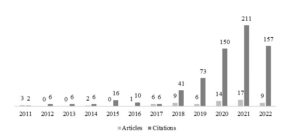
Fig 1. Evolution of the number of published articles and citations
Regarding the publishing sources, 32 were identified. Figure 2 shows the top-5 of the publications’ sources. As can be seen, the journal with the highest number of publications is Sustainability (Switzerland) (10 out of 67), that is, 14.9%. This journal publishes articles that fall into the following areas of study: (1) Social Sciences: Geography, Planning and Development; (2) Environmental Science: Environmental Science (miscellaneous); (3) Computer Science: Computer Science (miscellaneous); (4) Engineering: Building and Construction; (5) Social Sciences: Management, Monitoring, Policy and Law; (6) Computer Science: Computer Networks and Communications; (7) Energy: Energy Engineering and Power Technology; (8) Computer Science: Hardware and Architecture; (9) Energy: Renewable Energy, Sustainability and the Environment.
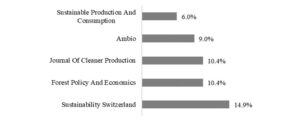
Fig 2. Top-5 of publication sources
Among the authors’ affiliation institutions, the one that stands out the most, out of 104 identified institutions, is the University of Helsinki (14.9%), an institution of great notoriety located in the city of Helsinki, in Finland (Figure 3).
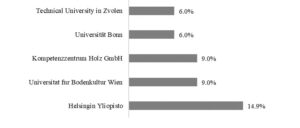
Fig 3. Top-5 of the authors’ affiliation institutions
The authors of the articles are associated with 21 nationalities. Four countries stand out with the number of articles published above 10%, namely, Germany which registered the highest percentage of publications (29.9%), followed by Finland (23.9%), Austria (11.9 %) and the United States (10.4%), as shown in Figure 4.
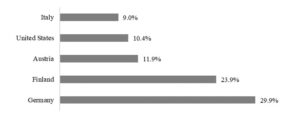
Fig 4. Top-5 of authors’ nationalities (countries)
Regarding the scientific areas of the published articles, 14 scientific areas were identified. The five areas with the greatest representation in terms of publications were Environmental Sciences (73.1%), Social Sciences (44.8%), Energy (43.3%), Agricultural and Biological Sciences (38.8 %) and Engineering (16.4%), as shown in Figure 5.
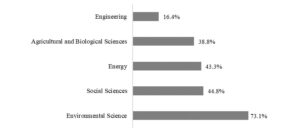
Fig 5. Top-5 of articles published by scientific area
54 funding agencies were identified. Funding resulted from programs and/or institutions such as the European Commission, Horizon 2020 Framework Program, among others (Figure 6).
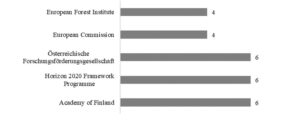
Fig 6. Top-5 of funding agencies
Table 1 shows the studies included in the h-index, that is, the number of articles by a given author with at least the same number of citations (Costas & Bordons, 2007). The h-index totalled 15 publications.
Table 1: H-index of literature on strategic groups’ perspectives about bioeconomy, Scopus
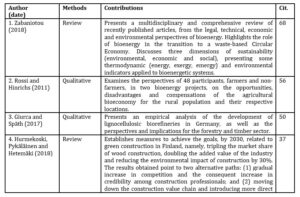
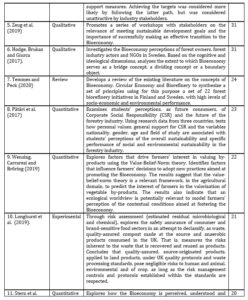
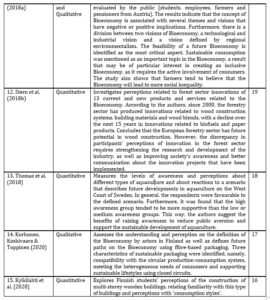
As can be seen in Table 1, of the articles that are part of the h-index, five are quantitative in nature. This type of study uses quantitative methods and statistical inference in order to extrapolate the results of a sample to the population. In this context, the quantitative study makes it possible to draw conclusions that can be extrapolated to a larger group than the one investigated. Five are qualitative in nature, that is, the authors try to broadly study and understand certain behaviours through the collection of narrative data, analysing the individual preferences of one or few elements that are the object of study, deepening, in this way, knowledge about them. Three studies consist of reviews of the existing literature. One study uses a mixed approach (quantitative and qualitative). Finally, there was one study of experimental nature, in which the authors try to obtain data through the manipulation of variables related to the object of study, namely, the microbiological and chemical analysis of consumption goods.
The most cited article, with 68 citations, consisted of a review and was developed by Zabaniotou (2018). The author argues that, in the context of the Circular Economy, the global bioenergy sector faces challenges, leveraged by the increased demand for biomaterials. According to the author, sustainable bioenergy paths should be selected based on high efficiency, closed loops and the concepts of waterfall and integrated biorefineries. At a regional level, bioenergy systems can be integrated into cascade biorefinery models or can offer waste management solutions through decentralized, autonomous and bespoke systems. Furthermore, the author argues that when redesigning the bioenergy sector, local knowledge, public health and community resilience should not be neglected. He adds that socio-environmental benefits must be considered when approaching the viability of bioenergy producers. In the author’s opinion, social acceptance can be improved if there is a better understanding of scientific and technical issues.
The most recent articles that are part of the h15-index were published in 2020. The first one was based on a review of the existing literature on the concepts of Bioeconomy, Circular Economy and Biorefinery to summarize a set of principles of 22 forest biorefinery initiatives in Finland and Sweden, with high levels of socio-economic and environmental performance. In this study, the authors concluded that the expectations of greater added value of products and greater sustainability with the use of closed circuits are rarely met. In other words, very few characteristics were found compatible with the circular Bioeconomy view (Temmes & Peck, 2020). The second article consisted of a qualitative study, which was based on 14 thematic interviews on Bioeconomy, carried out within members of the network of actors in Finland. The results showed that, in relation to the concept of Bioeconomy, opinions diverged widely. On the one hand, there are those who parallel the concept of Bioeconomy with the concept of a “Trojan horse”, that is, a new term to promote old political agendas, a totally new way of organizing a sustainable future. On the other hand, there are those who have a more sociological view of the concept, incorporating the Circular Economy and decoupling the use of resources from economic benefits. Furthermore, few respondents considered the more resource-efficient path of technological development as a more likely outcome for the fibre-based packaging business. Respondents considered that both social and technological innovations are, mutually, necessary to create more sustainable packaging production and consumption patterns. Finally, they identified three characteristics of sustainable packaging, namely, compatibility with the circular production-consumption system, satisfying the heterogeneous needs of consumers and supporting sustainable lifestyles (Korhonen, Koskivaara & Toppinen, 2020). The third article, of quantitative nature, aimed to know the consumers’ perceptions in relation to wood as an urban construction material for multi-storey buildings. The results indicate that the aesthetic appearance of wooden multi-story buildings is more appreciated by frugal and responsible consumers, while comfort, environmental friendliness and longevity are important factors for consumers who were identified as ‘conscious spenders’. According to the authors, young consumers who are already familiar with the use of wood in housing strongly contribute to a successful Bioeconomy in the urban context (Kylkilahti et al., 2020).
Analysis of thematic areas
Taking into account the analysis of thematic areas and using the VOSviewer software, version 1.6.18, using the binary counting method that selects only the documents where the words appear, a total of 2327 words were identified. Subsequently, the number of occurrences of a word in the total of analysed documents (67 articles) was defined as five, resulting in a total of 98 words. Of these, words with more than 60% relevance were selected, resulting in a total of 59 words, distributed across four thematic clusters (Figure 7).
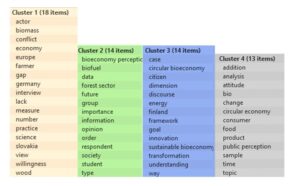
Fig 7. Words distributed by thematic clusters
The first cluster is composed of eighteen words (red colour in Figure 8), namely, actor, biomass, conflict, economy, Europe, farmer, gap, Germany, interview, lack, measure, number, practice, science, Slovakia, view, willingness, wood. This cluster included articles related to the perceptions about the Bioeconomy of the stakeholders from the timber sector and the different actors from the field of forestry action closest to the Bioeconomy field. In a study carried out in Germany, the authors identified different perceptions and interpretations of the Bioeconomy, often linked to political demands. The authors grouped the perspectives into two groups. The first group considers the forest as the primary production site and advocates adequate forest management. The second group refers to wood as the most important raw material for the Bioeconomy and requires the safety and planning necessary for harvesting (Hafner et al., 2020).
Giurca and Späth (2017) carried out an empirical analysis on the development of lignocellulosic biorefineries in Germany. The authors intended to make known the perceptions and implications of the Bioeconomy for the forestry and timber sector. In this study, special relevance was given to the perceptions of the most involved actors (forest and timber industry, chemical industry and energy sector), especially with regard to innovation. The authors concluded that this emerging area offers opportunities, however, internal and external weaknesses of the system were identified, namely, fragmented policies, formation of underdeveloped markets, technological immaturity, incomplete networks of actors, among others, which should be addressed and overtaken.
In this cluster, articles related to the use of wood in construction were also included. According to Karjalainen and Ilgın (2021), due to increasing urbanization, the need for sustainable housing, for example wooden housing, is growing in Finland. In the authors’ opinion, understanding residents’ perceptions plays a critical role in the transition to sustainable housing as an important part of the Bioeconomy. In this study, the authors analysed the change over time in Finnish residents’ attitudes towards multi-storey wooden apartment buildings. For this purpose, results from surveys of residents in 1998-1999 and 2017 were used and compared with each other. The results mainly highlighted that: (1) residents’ attitudes towards wooden apartment buildings remained positive over time; (2) participants in both surveys were satisfied with the functionality of the apartments; (3) the positive perception regarding sound insulation, indoor climate and cosiness did not change over time; (4) the dominant preferences of moving to one and two-story twin houses gradually gave way to two-story buildings and dwellings; (5) the demand for wooden buildings or apartments has increased over time; and (6) while fire and environmental properties were evaluated positively, impact sound insulation was still seen as an issue.
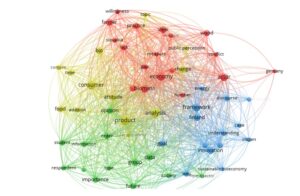
Fig 8. Map of the associations between the words grouped into thematic clusters
The second cluster included fourteen words (green colour in Figure 8), namely, bioeconomy perceptions, biofuel, data, forest sector, future, group, importance, information, opinion, order, respondent, society, student, type. In general, this cluster included articles related to the perception about the Bioeconomy by Civil Society, in general, and higher education students, in particular, as well as their opinions on the importance of the forestry sector for the Bioeconomy. According to Hodge, Brukas and Giurca (2017), Bioeconomy is a concept widely accepted and perceived as a natural extension of the forestry model. Forests play an increasing role in bioeconomy policies, providing the raw material for bio-based products (Baublyte et al., 2019; Ranacher, Ludvig & Schwarzbauer, 2019). For example, bioenergy produced from perennial raw materials, such as woody biomass, can serve as an opportunity to strengthen local and regional economies and also jointly produce diverse environmental services (Hand & Tyndall, 2018). In addition, wood-based innovations can substantially contribute to the Bioeconomy and future competitiveness of the forest-based sector (Ranacher et al., 2018).
On the other hand, the availability of underexploited agricultural residues opens the opportunity to provide for the production of bioethanol. National implementation of waste in biofuels can potentially boost the Bioeconomy and mitigation of greenhouse gases, but requires multi-stakeholder involvement in the development of effective coordinated recommendations and policies (Jusakulvijit, Bezama & Thrän, 2021; Giurca & Spath, 2017). For future sustainable bioenergy, the inclusion of stakeholder views in the development of recommendations and policies for advanced bioenergy can result in multifaceted scenarios that can be linked to social acceptance providing benefits to all relevant actors.
Short rotation plantations can also make an important contribution to the Bioeconomy, satisfying the growing demand for raw material (wood) and strengthening the rural economy. On the other hand, marginal lands are considered a promising option to produce biomass avoiding land use conflicts with food producers (Ranacher et al., 2021). In this context, it is important to mention the study developed by Tyndall, Schulte and Hall (2011). Given the substantial growth in demand for biofuels in the United States and although corn kernels continue, according to the authors, to constitute the primary feedstock for biofuel production, it is unlikely that a single biomass feedstock will meet to all the needs of the bioenergy market. Therefore, the authors sought to understand, with foresters from 5 states (Illinois, Iowa, Minnesota, Missouri and Wisconsin), that other types of available woody materials could sustain the biomass market. According to foresters, the physical abundance of low-cost cellulosic raw material resulting from crop residues can function as raw material for energy production.
In a study carried out in Slovakia on the concept of Bioeconomy (Navrátilová, Výboštok & Šálka, 2021), which involved 13 stakeholders, representatives of public and private organizations, from various sectors close to the Bioeconomy, forestry was considered a key sector for the Bioeconomy. The same results were obtained by Masiero et al. (2020).
According to Navrátilová, Výboštok and Šálka (2021), the success or not of the forest-based Bioeconomy depends, a lot, on the perception and attitudes of stakeholders towards the concept. According to the participants in this study, the forest-based Bioeconomy brings more opportunities for the forestry and wood processing sector, economy, industry, nature protection than risks. However, a significant threat was identified, that is, forestry actors do not feel sufficiently involved in the Bioeconomy discussion. In this sense, the authors concluded that for the Bioeconomy to fulfil its role as an “all-purpose weapon”, there is an urgent need to establish a more precise and concise political orientation and to involve all interested parties in the discussion (Navrátilová, Výboštok & Šálka, 2021).
The third cluster consisted of fourteen words (blue colour in Figure 8), namely, case, circular bioeconomy, citizen, dimension, discourse, energy, Finland, framework (scenario), goal, innovation, sustainable bioeconomy, transformation, understanding, way. The third cluster comprised articles that consider the Bioeconomy to be the innovative way to go in order to ensure the sustainability of the planet, highlighting the importance of knowing the perceptions and raising awareness of all strategic groups to ensure the successful transition to the Bioeconomy. The sectors of activity most directly involved have strong innovation potential as they profit from the knowledge and achievements of a wide range of sciences, including life sciences, ecology and food science, applied and industrial technologies of biotechnology and nanotechnology, and local and tacit knowledge (European Commission, Directorate-General for Research and Innovation, 2018). Therefore, Bioeconomy can be defined as “a new paradigm whose objective is to create, build and modernize an economic system based on the sustainable use of renewable biological resources” (Aguilar, Twardowski & Wohlgemuth, 2019).
Finally, the fourth cluster included thirteen words, namely, addition, analysis, attitude, bio, change, circular economy, consumer, food, product, public perception, sample, time and topic (yellow colour in Figure 8). In the fourth cluster, articles related to the perception of the Bioeconomy, consumer attitudes and behaviours regarding the acceptance of new bio food products resulting from the circular economy were included. In the opinion of Tsimitri et al. (2022), the exploitation of agro-food industrial by-products for the production of new foods is considered a promising strategy within the scope of policies to promote the Bioeconomy and Circular Economy. However, and despite the potential of new foods derived from agro-food industrial by-products, according to the authors, more information is needed on their use to increase consumer confidence.
A study developed in Finland involved 50 consumers and aimed to understand consumer behaviour, motivations, concerns and intentions related to bio-based products and brands taking into account a global concern approach associated with the sustainability of the Bioeconomy. In this research, the sustainability framework was built around four topics: (1) consumer awareness, (2) illustrated examples and consumer acceptance, (3) consumption habits and (4) future consumption behaviour. The main findings indicate that Finnish consumers were extremely well informed about the bio-based concept and were more confident in domestic regional brands. Throughout the survey, consumers highlighted the role of companies and called for sensible science-based communication on sustainability aspects. Finally, the results led to consider as value-sensitive consumer insights, the construction of environmental impact assessment measures, to be taken into account in decision making (Kymäläinen et al., 2022).
Mehta et al. (2021) developed an exploratory study in Belfast, Northern Ireland, which aimed to investigate the perceptions and opinions of three stakeholder groups on the use of bio-based plastics, namely, environmental professionals and plastic processors, university students, and consumers. During the focus groups (25 participants in total), samples of bio-based plastics were presented, including monolayer and multilayer based on starch and PET plastic (polyethylene terephthalate). A qualitative analysis using the framework method revealed that environmental professionals and plastic processors were aware of the benefits of bio-based plastics, for example, the reduction in the use of fossil fuels and the challenges, which include the use of agricultural land for substrates of biomass and possible contamination of current conventional plastic recycling streams. Although there was a general lack of knowledge among students and consumers about bio-based plastics, they conveyed their beliefs that the use of agricultural waste will lead to closed-loop systems, resulting in a balanced approach to production and waste management. Some students and consumers raised concerns about food contamination by bio-based packaging prepared from slaughterhouse waste. However, these participants supported the use of this waste in the production of bio-based plastics for non-food contact items. Furthermore, students and consumers and some of the environmental professionals and plastic processors were reluctant to pay more for bio-based plastics. Finally, the results indicate that bio-based plastics manufacturers can benefit from informing consumers about the environmental impacts of parameters such as production processes and raw materials. According to these participants, this information must be provided and incorporated into the labelling.
Conclusions
The transformation of the way in which societies are organized based on the Bioeconomy offers the opportunity to achieve more sustainability through the adoption of new approaches to deal with future challenges. However, for it to be successfully implemented, it is important that all strategic groups are involved in the discussion and decision-making.
This study involved a bibliometric analysis, on the perception of strategic groups about the Bioeconomy, based on 67 articles selected from the Scopus database. The objective was to group the literature into clusters of thematic areas. In this context, four clusters were identified. The first cluster comprised the articles referring to the perceptions about the Bioeconomy of the stakeholders in the timber sector and of the different actors in the field of forestry action closest to the Bioeconomy area. The second cluster included articles related to the perception of the Bioeconomy by stakeholders, namely, Civil Society, in general, and higher education students, in particular, as well as their opinions on the importance of the forestry sector for the Bioeconomy. The third cluster comprised articles that consider the Bioeconomy to be the innovative way to go to ensure the sustainability of the planet, which highlights the importance of knowing the perceptions and raising awareness of all strategic groups to ensure the successful transition to the Bioeconomy. Finally, the fourth cluster included articles related to the perception of the Bioeconomy, consumer attitudes and behaviours regarding the acceptance of new biofood products resulting from the Circular Economy.
Taking into account the clusters found, the line of research on the perceptions of higher education students on Bioeconomy stands out as very promising. As argued by Výbošt’ok et al. (2022), the social transition from linear economics to Bioeconomy requires the involvement of all stakeholders, especially young people, current and future consumers, and also future managers of this new area, which is why their involvement in the discussion, decision-making process and study of perceptions about the Bioeconomy is so important. Therefore, in the future, it is proposed to develop empirical research to analyse the perceptions and the level of knowledge about Bioeconomy in higher education students in Portugal and Brazil. Additionally, it is intended to know if there are, statistically, significant differences in the level of knowledge and perceptions about Bioeconomy, taking into account the scientific area of the degree they attend and the sociodemographic variables (nationality, gender, age, household size, residence and household income).
This research had some limitations. On the one hand, it was only supported by articles from the Scopus database. Despite being considered the most comprehensive bibliometric database in terms of peer-reviewed publications, there are other international databases that were excluded, namely, Web of Science, Scielo, among others. On the other hand, a filter was used to select only documents of the “Article” and “Review” type, excluding other types of documents, namely books, book chapters and conference documents.
This study highlights trends and developments in publications on stakeholders’ perceptions regarding the Bioeconomy and can help researchers to understand the state of the art in order to contribute to the development of future lines of research in this relatively recent topic. In practical terms, this study helps to raise awareness and inform readers about the need to adopt a more sustainable way of organizing Societies.
Acknowledgments
The authors are grateful to the Foundation for Science and Technology (FCT, Portugal) for financial support through national funds FCT/MCTES (PIDDAC) to CIMO (UIDB/00690/2020 and UIDP/00690/2020) and SusTEC (LA/P/0007/2020).
References
- Aguilar, A., Twardowski, T. and Wohlgemuth, R. (2019). ‘Bioeconomy for sustainable development.’ Biotechnology Journal, 14 (8), e1800638.
- Baublyte, G., Korhonen, J., D’Amato, D. and Toppinen, A. (2019). ‘Being one of the boys: perspectives from female forest industry leaders on gender diversity and the future of Nordic forest-based bioeconomy.’ Scandinavian Journal of Forest Research, 34 (6), 521-528.
- Costas, R. and Bordons, M. (2007). ‘The h-index: Advantages, limitations and its relation with other bibliometric indicators at the micro level.’ Journal of Informetrics, 1 (3), 193-203.
- Dallendörfer, M., Dieken, S., Henseleit, M., Siekmann, F. and Venghaus, S. (2021). ‘Investigating citizens’ perceptions of the bioeconomy in Germany – High support but little understanding.’ Sustainable Production and Consumption, 30 (2), 16-30.
- Dieken, S. and Venghaus, S. (2020). ‘Potential pathways to the German bioeconomy: A media discourse analysis of public perceptions.’ Sustainability (Switzerland), 12 (19), 7987.
- European Commission, Directorate-General for Research and Innovation (2018). A sustainable bioeconomy for Europe: strengthening the connection between economy, society and the environment: updated bioeconomy strategy, European Commission, Brussels.
- European Commission, Joint Research Centre (2018). ‘Brief on jobs and growth of the bioeconomy 2009- 2015,’ Publications Office [Online] [Retrieved September 7, 2022], https://data.europa.eu/doi/10.2760/157298
- Giurca, A. and Späth, P. (2017). ‘A forest-based bioeconomy for Germany? Strengths, weaknesses and policy options for lignocellulosic biorefineries.’ Journal of Cleaner Production, 153, 51-62.
- Grubor, A., Milicevic, N. and Djokic, N. (2018). ‘Serbian organic food consumer research and bioeconomy development.’ Sustainability (Switzerland), 10 (12), 4820.
- Hafner, M., Fehr, L., Springorum, J., Petkau, A. and Johler, R. (2020). ‘Perceptions of bioeconomy and the desire for governmental action: Regional actors’ connotations of wood-based bioeconomy in Germany.’ Sustainability (Switzerland), 12 (23), 9792.
- Hand, A. M. and Tyndall, J. C. (2018). ‘A qualitative investigation of farmer and rancher perceptions of trees and woody biomass production on marginal agricultural land.’ Forests, 9 (11), 724.
- Hodge, D., Brukas, V. and Giurca, A. (2017). ‘Forests in a bioeconomy: bridge, boundary or divide?’ Scandinavian Journal of Forest Research, 32 (7), 582-587.
- Hurmekoski, E., Pykäläinen, J. and Hetemäki, L. (2018). ‘Long-term targets for green building: Explorative Delphi backcasting study on wood-frame multi-story construction in Finland.’ Journal of Cleaner Production, 172, 3644-3654.
- Jusakulvijit, P., Bezama, A. and Thrän, D. (2021). ‘Criteria prioritization for the sustainable development of second-generation bioethanol in Thailand using the Delphi-AHP technique.’ Energy, Sustainability and Society, 11 (1), 37.
- Karjalainen, M. and Ilgın, H.E. (2021). ‘The change over time in Finnish residents’ attitudes towards multi-story timber apartment buildings.’ Sustainability (Switzerland), 13 (10), 5501.
- Korhonen, J., Koskivaara, A. and Toppinen, A. (2020). ‘Riding a Trojan horse? Future pathways of the fiber-based packaging industry in the bioeconomy.’ Forest Policy and Economics, 110, 101799.
- Krajewski, P. (2019). ‘Bioeconomy – Opportunities and dilemmas in the context of human rights protection and environmental resource management.’ Problemy Ekorozwoju, 14 (2), 71-79.
- Kylkilahti, E., Berghäll, S., Autio, M., Nurminen, J. Toivonen, R., Lähtinen, K. Vihemäki, H., Franzini, F. and Toppinen, A. (2020). ‘A consumer-driven bioeconomy in housing? Combining consumption style with students’ perceptions of the use of wood in multi-storey buildings.’ Ambio, 49 (12), 1943-1957.
- Kymäläinen, T., Vehmas, K., Kangas, H., Majaniemi, S. and Vainio-Kaila, T. (2022). ‘Consumer Perspectives on Bio-Based Products and Brands – A Regional Finnish Social Study with Future Consumers.’ Sustainability (Switzerland), 14 (6), 3665.
- Lokko, Y., Heijde, M., Schebesta, K., Scholtes, P. and Montagu MG. (2018). ‘Biotechnology and the bioeconomy- towards inclusive and sustainable industrial development.’ New Biotechnology, 40 (Pt A), 5–10.
- Longhurst, P.J., Tompkins, D., Pollard, S.J.T., (…), Leinster, P. and Sweet, N. (2019). ‘Risk assessments for quality-assured, source-segregated composts and anaerobic digestates for a circular bioeconomy in the UK.’ Environment International, 127, 253-266.
- Macht, J., Klink-Lehmann, J.L. and Simons, J. (2022). ‘German citizens’ perception of the transition towards a sustainable bioeconomy: A glimpse into the Rheinische Revier.’ Sustainable Production and Consumption, 31, 175-189.
- Masiero, M., Secco, L., Pettenella, D., (…), Výbošťok, J. and Wallin, I. (2020). ‘Bioeconomy perception by future stakeholders: Hearing from European forestry students.’ Ambio, 49 (12), 1925-1942.
- McCormick, K. and Kautto, N. (2013). ‘The Bioeconomy in Europe: An Overview.’ Sustainability (Switzerland), 5 (6), 2589-2608.
- Mehta, N., Cunningham, E., Roy, D., (…), Berry, E. and Smyth, B.M. (2021). ‘Exploring perceptions of environmental professionals, plastic processors, students and consumers of bio-based plastics: Informing the development of the sector.’ Sustainable Production and Consumption, 26, 574-587.
- Moosmann, D., Majer, S., Ugarte, S., Ladu,L., Wurster, S. and Thrän, D. (2020). ‘Strengths and gaps of the EU frameworks for the sustainability assessment of bio-based products and bioenergy.’ Energy, Sustainability and Society, 11 (22), 1-19.
- Navrátilová, L., Výboštok, J. and Šálka, J. (2021). ‘Stakeholders and their view on forest-based bioeconomy in Slovakia.’ Central European Forestry Journal, 67 (4), 240-247.
- Oriama, R. and Pyka, A. (2021). ‘Understanding the transformation to a knowledge-based health bioeconomy: Exploring dynamics linked to preventive medicine in Kenya.’ Sustainability (Switzerland), 13 (21), 12162.
- Pätäri, S., Arminen, H., Albareda, L., Puumalainen, K. and Toppinen, A. (2017). ‘Student values and perceptions of corporate social responsibility in the forest industry on the road to a bioeconomy.’ Forest Policy and Economics, 85, 201-215.
- Ramcilovic-Suominen, S. and Pülzl, H. (2018). ‘Sustainable development – A ‘selling point’ of the emerging EU bioeconomy policy framework?’ Journal of Cleaner Production, 172, 4170-4180.
- Ranacher, L., Höfferer, K., Lettner, M., (…), Rauter, R. and Schwarzbauer, P. (2018). ‘What would potential future opinion leaders like to know? An explorative study on the perceptions of four wood-based innovations.’ Bodenkultur, 69 (1), 47-59.
- Ranacher, L., Ludvig, A. and Schwarzbauer, P. (2019). ‘Depicting the peril and not the potential of forests for a biobased economy? A qualitative content analysis on online news media coverage in German language articles.’ Forest Policy and Economics, 106,101970.
- Ranacher, L., Pollakova, B., Schwarzbauer, P., (…), Weber, N. and Hesser, F. (2021). ‘Farmers’ Willingness to Adopt Short Rotation Plantations on Marginal Lands: Qualitative Study About Incentives and Barriers in Slovakia.’ Bioenergy Research, 14 (2), 357-373.
- Rossi, A. M. and Hinrichs, C. C. (2011). ‘Hope and skepticism: Farmer and local com-munity views on the socio-economic benefits of agricultural bioenergy.’ Biomass and Bioenergy, 35 (4), 1418-1428.
- Santos, A. A., Neto, J. V. and Filho, J. R. F. (2016). ‘Three Decades in Development the Eco-Efficiency: A Bibliometric Study the Activity in Search in Literature Scientific Indexed in Scopus Base.’ Espacios, 37 (1), 1-20.
- Sanz-Hernández, A., Esteban, E., Marco, P. and Soriano, G. (2020). ‘Forest bioeconomy in the media discourse in Spain.’ Ambio, 49 (12), 1897-1911.
- Stern, T., Ploll, U., Spies, R., Schwarzbauer, P., Hesser, F. and Ranacher, L. (2018a). ‘Understanding perceptions of the bioeconomy in Austria – An explorative case study.’ Sustainability (Switzerland), 10 (11), 4142.
- Stern, T., Ranacher, L., Mair, C., Berghäll, S., Lähtinen, K., Forsblom, M. and Toppinen, A. (2018b). ‘Perceptions on the importance of forest sector innovations: Biofuels, biomaterials, or niche products?’ Forests, 9 (5), 1-13.
- Temmes, A. and Peck, P. (2020). ‘Do forest biorefineries fit with working principles of a circular bioeconomy? A case of Finnish and Swedish initiatives.’ Forest Policy and Economics,’ 110, 101896.
- Thomas, J.-B.E., Nordström, J., Risén, E., Malmström, M.E. and Gröndahl, F. (2018). ‘The perception of aquaculture on the Swedish West Coast.’ Ambio, 47 (4), 398-409.
- Tsimitri, P., Michailidis, A., Loizou, E., (…), Mugampoza, E. and Nastis, S.A. (2022). ‘Novel Foods and Neophobia: Evidence from Greece, Cyprus, and Uganda.’ Resources, 11 (1), 2.
- Urmetzer, S., Schlaile, M.P., Blok, V. and Pyka, A. (2022). ‘Quo Vadis, Bioeconomy? the Necessity of Normative Considerations in the Transition.’ Journal of Agricultural and Environmental Ethics, 35 (1),1-7.
- van Eck, N. and Waltman, L. (2011). ‘Text mining and visualization using VOSviever.’ ISSI News-letter, 7 (3), 238-260.
- Výbošt’ok, J., Navrátilová, L., Dobšinská, Z., Dúbravská, B., Giertliová, B., Aláč, P., Suja, M. and Šálka, J. (2022). ‘Bioeconomy perception by students of different study programs – study from Slovakia.’ Central European Forestry Journal, 68 (2), 91-100.
- Wensing, J., Carraresi, L. and Bröring, S. (2019). ‘Do pro-environmental values, beliefs and norms drive farmers’ interest in novel practices fostering the Bioeconomy?’ Journal of Environmental Management, 232, 858-867.
- Wozniak, E., Tyczewska, A. and Twardowski, T. (2021). ‘Bioeconomy develop-ment factors in the European Union and Poland.’ New Biotechnology, 60, 2–8.
- Zabaniotou, A. (2018). ‘Redesigning a bioenergy sector in EU in the transition to circular waste-based Bioeconomy-A multidisciplinary review.’ Journal of Cleaner Production, 177, 197-206.
- Zeug, W., Bezama, A., Moesenfechtel, U., Jähkel, A. and Thrän, D. (2019). ‘Stakeholders’ interests and perceptions of bioeconomy monitoring using a sustainable development goal framework.’ Sustainability (Switzerland), 11 (6), 1511.













